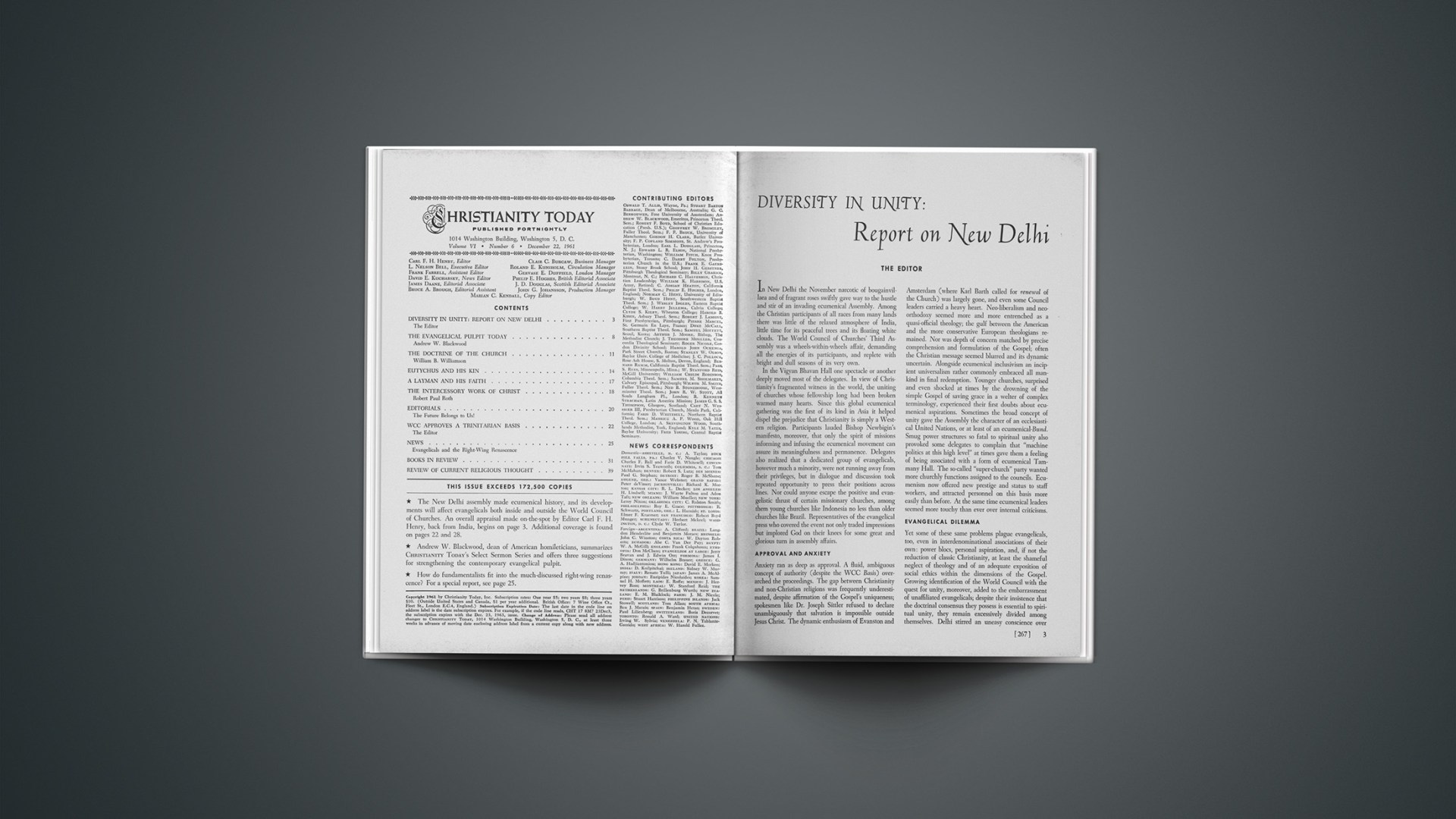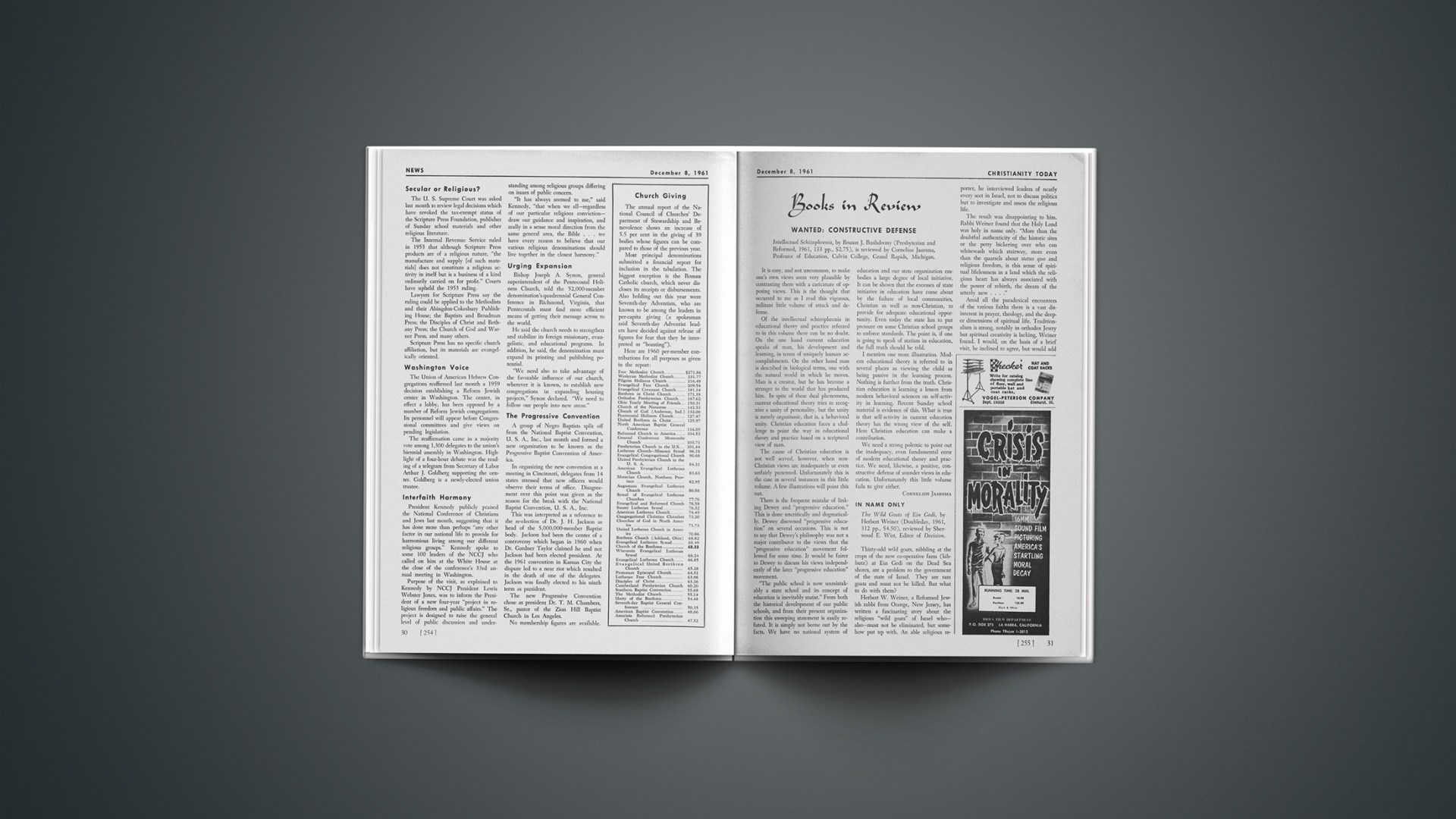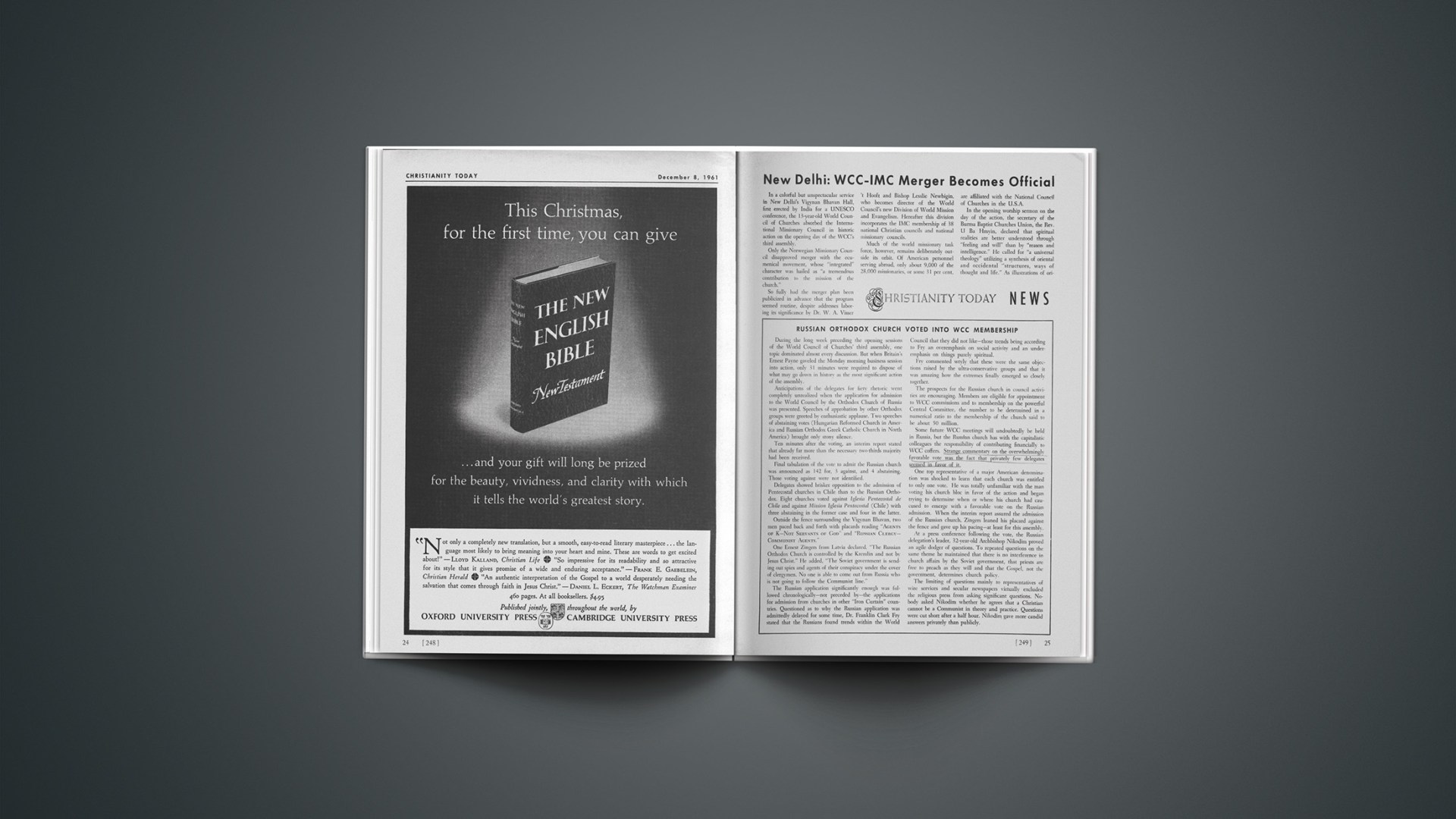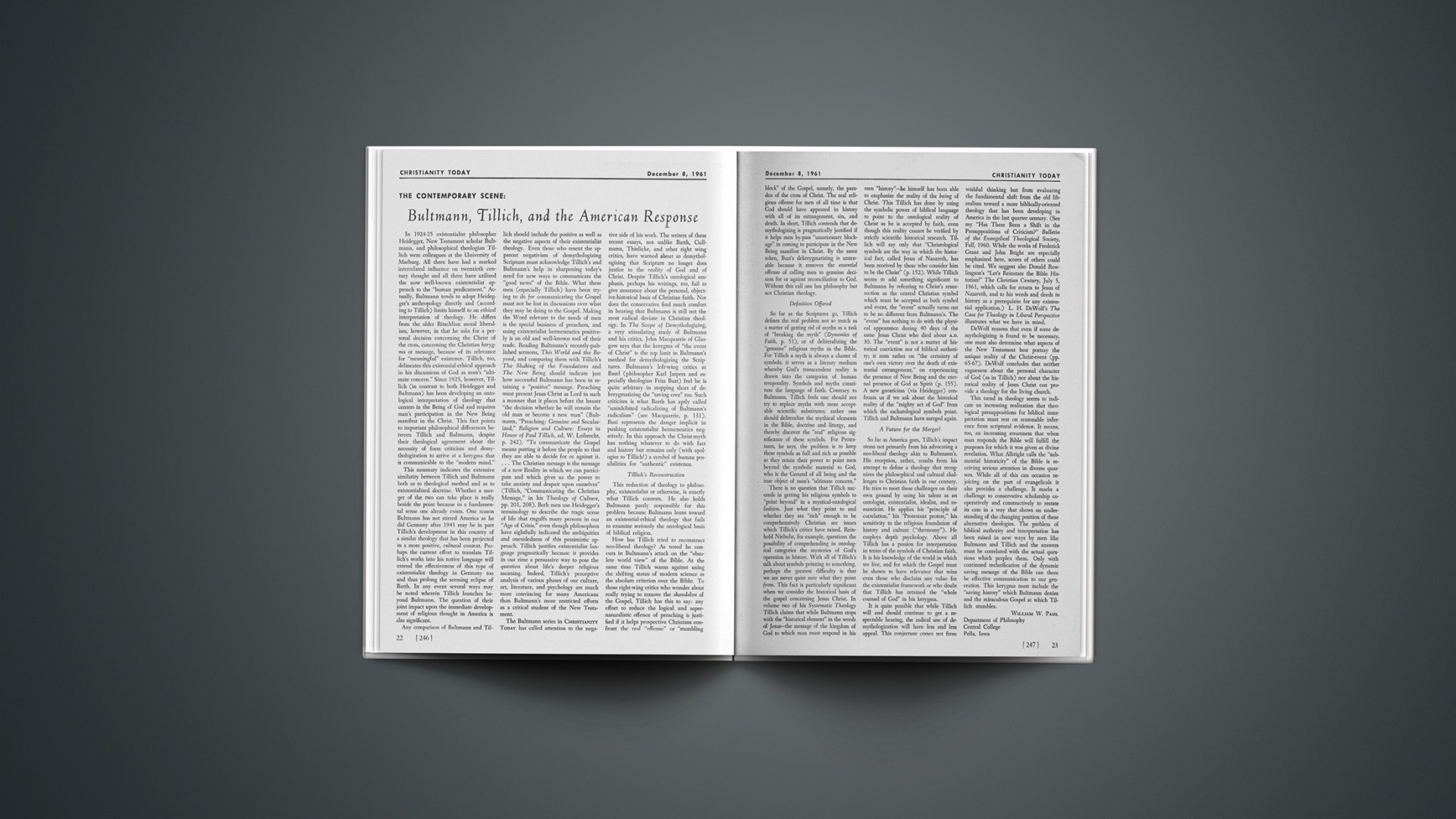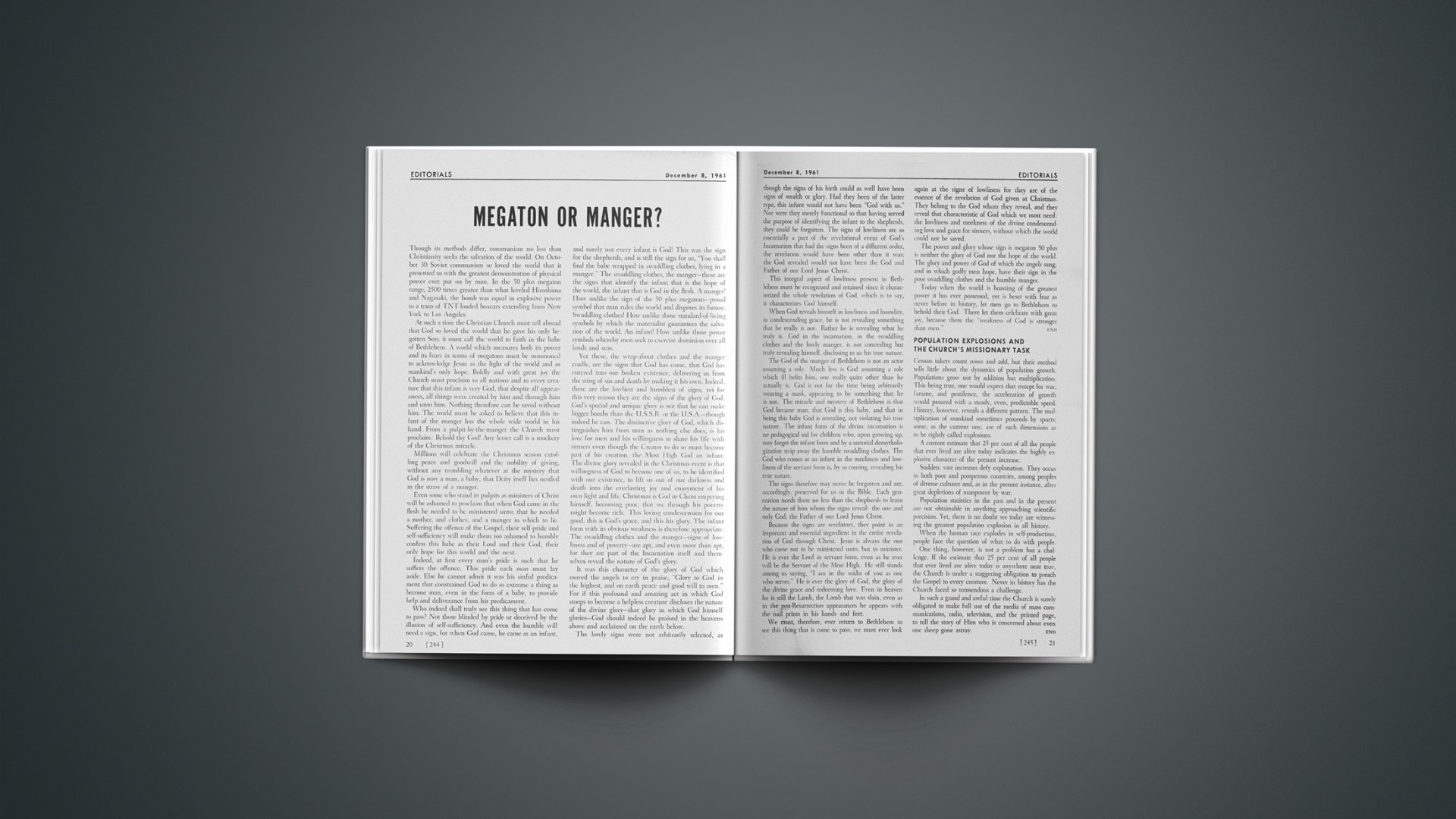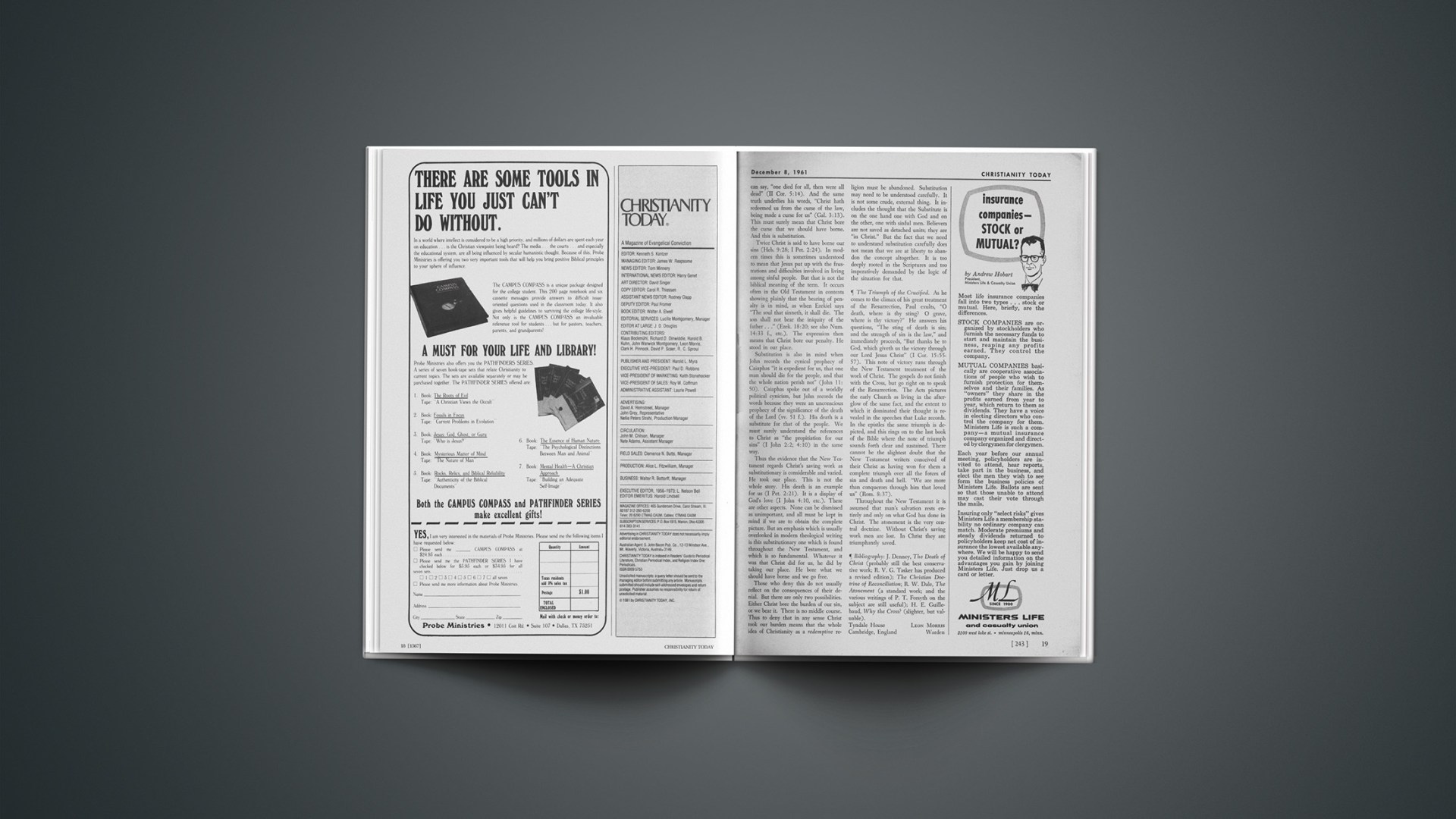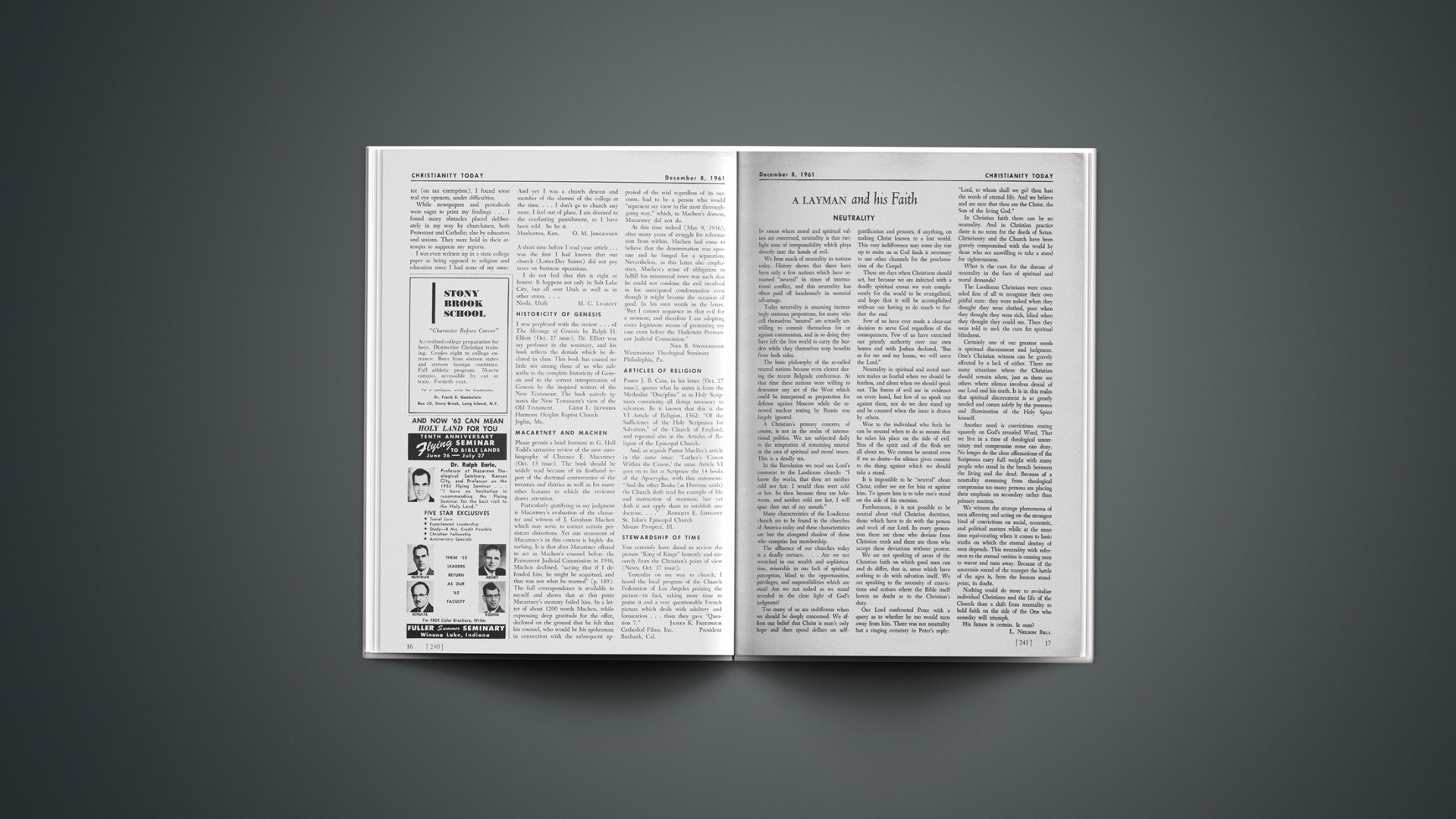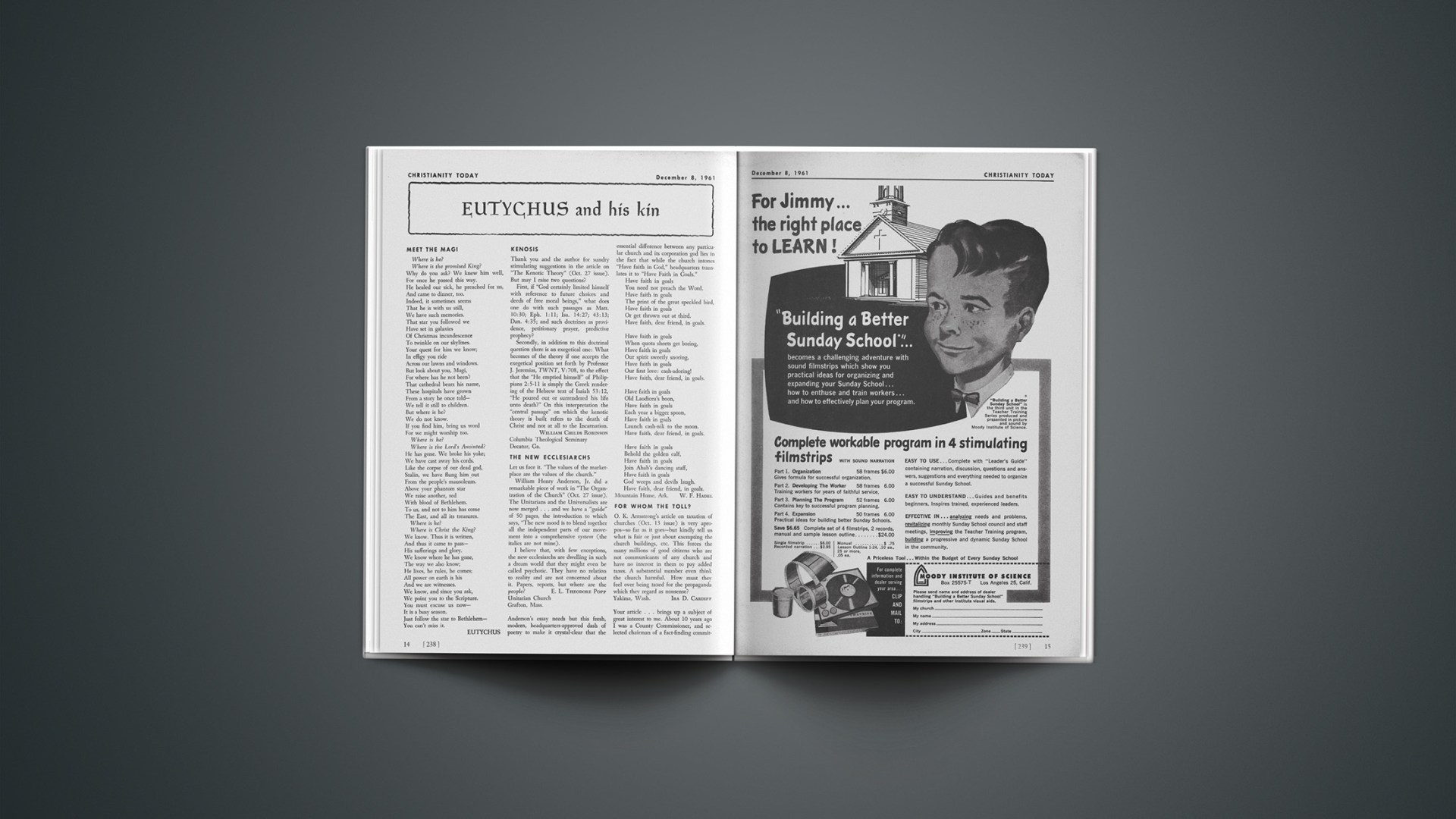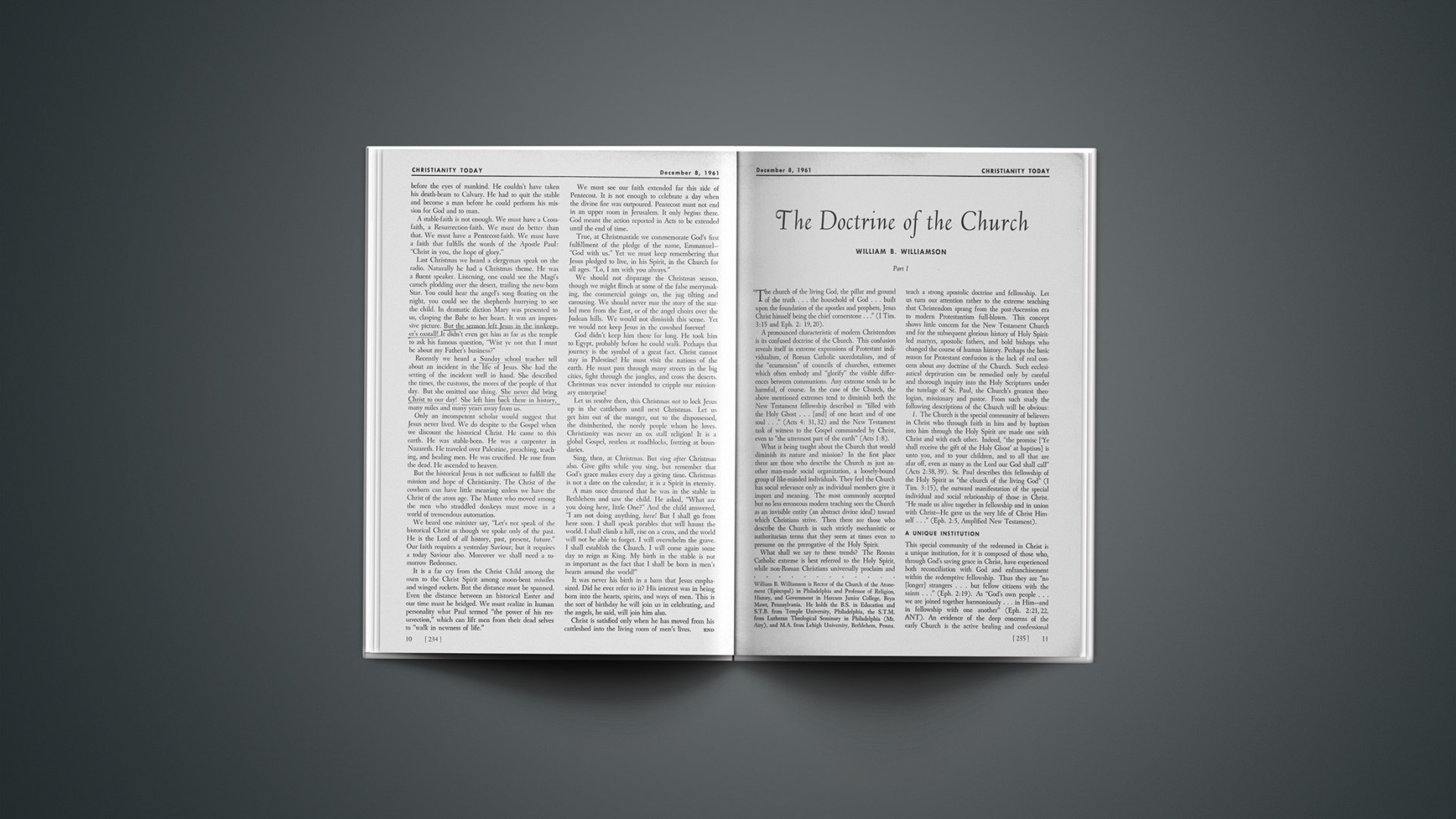THE EDITOR
In New Delhi the November narcotic of bougainvillaea and of fragrant roses swiftly gave way to the hustle and stir of an invading ecumenical Assembly. Among the Christian participants of all races from many lands there was little of the relaxed atmosphere of India, little time for its peaceful trees and its floating white clouds. The World Council of Churches’ Third Assembly was a wheels-within-wheels affair, demanding all the energies of its participants, and replete with bright and dull seasons of its very own.
In the Vigyan Bhavan Hall one spectacle or another deeply moved most of the delegates. In view of Christianity’s fragmented witness in the world, the uniting of churches whose fellowship long had been broken warmed many hearts. Since this global ecumenical gathering was the first of its kind in Asia it helped dispel the prejudice that Christianity is simply a Western religion. Participants lauded Bishop Newbigin’s manifesto, moreover, that only the spirit of missions informing and infusing the ecumenical movement can assure its meaningfulness and permanence. Delegates also realized that a dedicated group of evangelicals, however much a minority, were not running away from their privileges, but in dialogue and discussion took repeated opportunity to press their positions across lines. Nor could anyone escape the positive and evangelistic thrust of certain missionary churches, among them young churches like Indonesia no less than older churches like Brazil. Representatives of the evangelical press who covered the event not only traded impressions but implored God on their knees for some great and glorious turn in assembly affairs.
Approval And Anxiety
Anxiety ran as deep as approval. A fluid, ambiguous concept of authority (despite the WCC Basis) overarched the proceedings. The gap between Christianity and non-Christian religions was frequently underesti-mated, despite affirmation of the Gospel’s uniqueness; spokesmen like Dr. Joseph Sittler refused to declare unambiguously that salvation is impossible outside Jesus Christ. The dynamic enthusiasm of Evanston and Amsterdam (where Karl Barth called for renewal of the Church) was largely gone, and even some Council leaders carried a heavy heart. Neo-liberalism and neo-orthodoxy seemed more and more entrenched as a quasi-official theology; the gulf between the American and the more conservative European theologians remained. Nor was depth of concern matched by precise comprehension and formulation of the Gospel; often the Christian message seemed blurred and its dynamic uncertain. Alongside ecumenical inclusivism an incipient universalism rather commonly embraced all mankind in final redemption. Younger churches, surprised and even shocked at times by the drowning of the simple Gospel of saving grace in a welter of complex terminology, experienced their first doubts about ecumenical aspirations. Sometimes the broad concept of unity gave the Assembly the character of an ecclesiastical United Nations, or at least of an ecumenical-Bund. Smug power structures so fatal to spiritual unity also provoked some delegates to complain that “machine politics at this high level” at times gave them a feeling of being associated with a form of ecumenical Tammany Hall. The so-called “super-church” party wanted more churchly functions assigned to the councils. Ecumenism now offered new prestige and status to staff workers, and attracted personnel on this basis more easily than before. At the same time ecumenical leaders seemed more touchy than ever over internal criticisms.
Evangelical Dilemma
Yet some of these same problems plague evangelicals, too, even in interdenominational associations of their own: power blocs, personal aspiration, and, if not the reduction of classic Christianity, at least the shameful neglect of theology and of an adequate exposition of social ethics within the dimensions of the Gospel. Growing identification of the World Council with the quest for unity, moreover, added to the embarrassment of unaffiliated evangelicals; despite their insistence that the doctrinal consensus they possess is essential to spiritual unity, they remain excessively divided among themselves. Delhi stirred an uneasy conscience over evangelical ecumenism and demanded a new posture. Delegates from lands without an effective alternative insisted: “We evangelicals should enter into every discussion without losing freedom of thought and action.” They pointed to scores of men inside WCC who have “no qualms about historic Christianity” and pleaded for a charitable verdict which assumes their motives are good. Others cautioned: “Get in only if you have something to say and have the men with theological precision and evangelistic drive to say it. Their plea was for more evangelicals to press home the biting relevance of the Bible even if infiltration is the only way to do it. Beyond this expression, however, was a desire by some evangelicals to be identified with “the whole body of Christ”; for them evangelical fragmentation offers less than ecumenical inclusivism. The World Council’s appeal had been widened, some thought, by generalizations in certain fundamentalist literature that condemn ecumenism on bias rather than on critical assessment of principle; by the temptation of some conservative groups to rest their appeal more on what they oppose than on what they champion; by the ready tagging as nonevangelical all who are unaffiliated with some specific organization; and above all, by evangelicals’ failure to lead their own constituencies into deep theological renewal, into serious study of the doctrine of the Church, or into soul-searching concern over evangelical disunity.
Turning Point In Ecumenism
At the same time Delhi proceedings marked a turn in ecumenical destinies that more than ever may discourage evangelical identification with WCC. Admission of four additional Orthodox churches (Russian, 50 million members; Rumanian, 13 million; Bulgarian, 6 million; Polish, 400,000) presaged an end to the predominantly Protestant character of the World Council. Previously the WCC’s largest membership was claimed by The Methodist Church (U.S.A., 10 million). The membership of the Orthodox communions now admitted to the World Council in Delhi (exclusive of previously-associated Orthodox churches) is about twice that of the Protestant member bodies of the National Council of Churches, U.S.A. The strength of the sacramental-ritualistic tendency now prominent in the World Council includes also many Anglo-Catholics, and removes most obstacles to approaching the Roman Catholics. President H. “Pitt” Van Dusen of Union Theological Seminary, New York, said at Delhi that there can be no effective world ecumenicity until the Roman Catholics are brought in. In principle, the WCC’s present outreach already sweeps far behind the Reformation and, in fact, points behind the cleft between Eastern and Western Christianity to an ecclesiastical complex evident over 1500 years ago. The Orthodox churches consider themselves the ancient font of ecclesiastical unity and, on the basis of a patriarchal encyclical issued in 1920 “on which the Ecumenical movement of the WCC is based,” credit themselves with giving impetus to modern ecumenism. The Ethiopian Orthodox Church greeted Delhi delegates with this reminder: “Ever since the disagreements with the churches of the Roman Empire at Chalcedon in A.D. 451, the Oriental Orthodox churches—the Armenian, the Coptic, the Ethiopian, the Indian, and the Syrian—have been obliged to tread their own ways to maintain and foster the Orthodox faith in its purity as handed down by the great Fathers.… The question of unity should continue to be studied at the level of the confessional and traditional units.…” After admission to WCC, Patriarch Alexis of Moscow and all Russia said that “the Russian Orthodox Church is prepared to strengthen the Orthodox witness of her Sister-Churches.” The Russian Orthodox are believed to be thinking in terms of influencing and mobilizing the Greek Orthodox.
Eastern Orthodox Churches
ISSUE 7:32
Three Acute Problems
Admission of the Russian Orthodox Church with its 50 million members confronts the WCC with three specific problems: ecclesiastical, political, and evangelistic.
1. Ecclesiastical. The Protestant character of the Anglo-Saxon ecumenical thrust is now influenced or qualified in a major way by the Orthodox sacramen-that Protestant Christianity, with its current lack of a common theology and ecclesiology, will henceforth be increasingly on the defensive within the ecumenical encounter.
2. Political. Admission of the Orthodox churches creates within the WCC an East Zone potential of almost 40 delegates who are directly exposed to Kremlin political pressures. Although Lutheran and Reformed tarian-ritualistic emphasis. This trend has been encouraged by Protestant liberalism, whose disinterest in revealed theology has been accompanied by a yearning for ritual. The great bulk of the Eastern Orthodox churches are now WCC-affiliated, exceptions being the patriarchate of Yugoslavia (Serbia), the Georgian patriarchate in South Russia, and some small churches in scattered lands. The Orthodox churches consider the Third Assembly as their entry into a new period of ecumenical relations, especially in matters of faith and order. Dr. Nikos Nissiotis, assistant director of the Ecumenical Institute at Bossey, thinks the era of “ecumenical politeness,” when the Orthodox churches confessed their position only in an apologetic way, is over. He foresees, instead, their aggressive leadership in the exposition of an ideal pattern of ecclesiastical unity. The 17 members of Eastern Orthodox churches (five from the newly admitted Russian Orthodox Church) now comprise the largest single bloc in WCC’s 100-member central committee.
Christian Population Of The World
Main Source: Encyclopaedia Britannica 1960 Book of the Year
Accurate statistics on the present WCC constituency are exasperatingly difficult to get. At the Evanston Assembly that constituency was placed at 170 million. On the eve of the Delhi Assembly the World Council claimed that its “member churches represent approximately 70 per cent of the estimated 315 million Protestant, Orthodox and Anglican Christians in the world,” hence a constituency of 220,500,000. The post-Delhi constituency is sometimes pegged at 300 million, but ecumenical press aides privately concede that a case can be made (on the basis of one authority or another) for a figure ranging between 200 and 315 million. Constituency of the World Evangelical Fellowship is estimated at 25 million. Certainly any charting of the Christian population of the world leaves little doubt churches in Hungary, Poland, and Rumania have been WCC-identified, they have heretofore not been permitted full delegation representation. But at Delhi, where action was taken on the Russian Orthodox Church, all the churches were now permitted to send full delegations. The Orthodox applications by Poland. Rumania, and Hungary came to the World Council after that of Russia. Some leaders in churches that withheld support for admission of the Russian churches insist that more than half of the delegates from East Zone churches are Communist informants. When they left Geneva after their exploratory visit, the Russian delegates took back 1½ tons of WCC literature to duplicate, explaining that they would have to yield one set of materials at the border. In any event, the WCC now includes 16 delegates from Russia, six from Hungary, six from Czechoslovakia, five from Poland, four from Rumania, and one from Bulgaria. Could this development portend a Trojan horse of disaster for WCC? Should the Kremlin seek to embarrass ecumenical Christianity, it could at any time pressure Soviet-zone delegates to withdraw on the edge of a political issue, and thereby presumably split WCC leadership.
The Russian Orthodox delegation had declared in advance that its interest would center primarily in faith and order concerns. Its 32-year-old leader Archbishop Nikodim Rostov heads the office of Foreign Church Relations of the Moscow Patriarchate; prominence within his church has come so swiftly that many outsiders have questioned Nikodim’s freedom from state influence. The day after the Russian church’s admission, as the Assembly moved to section meetings on unity, service, and witness, Nikodim read a message from Patriarch Alexis of Moscow and All Russia declaring that the preservation and consolidation of world peace “is the basic problem of the times,” that “all Christians must resolutely call upon and induce all leaders of States to agree on universal and complete disarmament, with effective international control.” It was difficult indeed to catalogue this thesis under faith and order. Nor had the Russians given any advance indication that their participation would be wholly limited to doctrinal matters, although historically their church has had little interest in social action. Nikodim took every opportunity to stress publicly the Russian church’s freedom of interference from the state, although he tended to equate religious liberty with confessional freedom.
Of WCC’s 149 churches sending delegates to Delhi, only three voted against admission of the Russian Orthodox; four abstained. Opposition to admitting two Chilean Pentecostal groups was actually stronger than to admitting the Russian Orthodox. The Russian Orthodox Greek Catholic Church of America and the Hungarian Reformed Churches in America abstained from supporting the Russian Orthodox application. Although the delegates representing the Hungarian refugees in America first wanted to cast a negative vote, they followed the lead of the Russian exiles, who argued that if among the 16 Russian delegates there was only one real believer it would be nobler to abstain than to oppose because of the sufferings of Christians in the Soviet. No debate of the question was permitted. WCC leaders refused to identify the other dissenters. According to Dr. Eugene Carson Blake, the ballots were impounded as soon as the tellers made their reports and nobody, he told the press, knew who voted against the Russian Orthodox. Speculation was that delegates from Korea, Formosa, and possibly the Presbyterian Church in the U. S. had either opposed or abstained. While the Russian Orthodox probably would not immediately be directly represented on the Central Committee, occasional WCC meetings were now virtually sure to be held in Russia. (See editorial, “Was World Council Blackmailed to Admit Russian Churchmen?” p. 21).
Now that the Russian Orthodox were affiliated, the question promptly arose whether WCC any longer possesses the capacity to condemn the evil of communism in depth. Said Evangelist Billy Graham, a Delhi observer, who had to leave the assembly at its midpoint, “Thus far the Assembly has been almost silent on the problem that militant atheistic communism poses for the Church.” Among the dynamisms threatening to engulf the world, neither the non-Christian religions nor secularism nor scientism holds the terror that communism does as an antichrist philosophy. WCC statements concerning communism will be scanned more critically now than ever.
In closed-door sessions of WCC’s International Affairs Committee, the controversial Czech theologian Josef L. Hromádka successfully plugged for a nongovernmental East-West conference to break the nuclear test ban deadlock in the interest of international disarmament. Hromádka last June chaired the Prague All-Christian Peace Conference exploited by Soviet peace propagandists who are strangely silent about Communist class warfare. In its Delhi turnover of six presidents, staunch anti-communist Bishop Otto Dibelius gave way to pacifist-minded Dr. Martin Niemöller, president of the Evangelical Church of Hesse—Nassau in Germany, on the WCC Presidium.
3. Evangelistic. The third problem now acutely faced by WCC concerns evangelism and proselytism. Throughout the Christian centuries, movements that reject the legitimacy of sacramental regeneration and that insist on the need for personal faith in Christ—both the despised “cults” outside medieval Romanism and post-Reformation churches—have viewed sacramentarian churches as an evangelistic and missionary objective. Orthodox and Roman Catholic churches, on the other hand, have harassed and repressed evangelical effort. Soon after his church’s admission to WCC, Patriarch Alexis said, in fact, “The Russian Orthodox Church has always seen her sacred duty … in making [this heritage] widely known.… However, the Russian Orthodox Church has never identified this witness with proselytizing or other such non-Christian acts.”
While the Roman church has scorned Protestant proselytizing, it has maintained its own right to proselytize Protestants on the basis that there is no salvation outside the (Roman) church. Protestants, on the other hand, have never maintained that Roman Catholics cannot be true believers. Deference to Romanist views was evident here and there at Delhi. One delegate, for example, argued that Billy Graham’s upcoming evangelistic campaign in Latin America cannot be considered ecumenically successful unless Roman Catholics participate in it.
It is certainly obvious that churches underwriting Christian unity of the ecumenical movement cannot view other member churches as missionary objectives. Within the ecumenical dialogue, participating churches can still witness to each other (at this stage) in an educational program where evangelism is reduced to enlightenment, but to deny the validity of the Christian experience of affiliated constituencies is quite another matter. This ecumenical tolerance, in fact, is what sharpens resentment toward aggressive fundamentalist and evangelical groups. One bishop privately denounced fundamentalist workers in his part of Asia as divisive. “They say that Mohammedans and Buddhists are not Christians. They say I’m unconverted and a false prophet. They insist on a statement of faith.”
Against this background one can understand the drama that surrounded the Delhi entrance into the World Council of the first Pentecostal agencies, namely, the Iglesia Pentecostal de Chile and Mission Iglesia Pentecostal (Chile). On the one hand, WCC leaders rejoiced over “a Pentecostal breakthrough” (only 20,000 members were involved), especially since in the United States this prong of the so-called “third force” is intimately linked to the National Association of Evangelicals. The Chilean Pentecostals had become interested in WCC through the abundance of Church World Service relief supplies during an earthquake disaster. On the other hand, WCC member churches greeted the Pentecostal applications with as many abstentions and with almost three times as many outright rejections (eight) as the Russian Orthodox application (three). The opposition was said to come from the Orthodox type of church that resents aggressive Pentecostal evangelistic methods. (It was interesting that reporters were given this information about opposition to the Pentecostal churches, but were told that no one knows who opposed the Russian Orthodox entry.) Pentecostalists had now to decide whether in good conscience they could or could not continue to evangelize members of the ecumenical body.
An Evangelical Crossroad
Admission of additional sacramental communions which blurred the earlier Protestant character of WCC could hardly brighten the prospect of enlisting many more of the unaffiliated evangelical bodies. The WCC’s failure to enlist such groups remains particularly conspicuous on the American scene, where 24 million Protestants remain outside the National Council of Churches, including large denominations like the Southern Baptists, as well as constituencies of the National Association of Evangelicals and American Council of Churches. Although in 1961 the term “ecumenical” seemed less esoteric than at Evanston and Amsterdam, it still fell far short of being synonymous with the Church universal. Not only had regular contact been lost with the churches in Red China, but new applications for membership scarcely concealed the fact that the thin Latin American participation in World Council affairs also perpetuates a geographical weakness in the movement’s world-wide representations. Through face-to-face conferences and consultations, ecumenical leaders continue to probe the possibility of larger evangelical identification. The joint committee of WCC-IMC had also explored means of gaining closer touch with bodies espousing evangelical views. Special consultations on evangelism are aimed at “providing a place in the Ecumenical Movement where representatives of ‘evangelical’ church groups can make their contribution.” But the fact is that a considerable segment of world Christianity still does not look to the World Council as a desirable instrument.
At Delhi evangelical participants were being driven to ask more deeply than ever before whether the renewal of the Church is being achieved through the present ecumenical process of ecclesiastical elephantiasis. They were left with the vexing question whether the widening Orthodox ecclesiastical trend already so neutralizes the Protestant orientation that they, no less than unaffiliated evangelicals, may soon find the climate of WCC less compatible than will the Roman Catholics. Not a few were disturbed that ecumenical assimilation in many respects now looks more like a pious version of the U. N. than like a recapturing of the essence of New Testament community. The Statesman in Delhi observed that distinguished speakers were “confounding confusion” in their divergent approaches and proposed solutions to “the schismatic disunity of the One United Church.” As some leaders rebuked those who prize their separate traditions, others asked with fresh awareness whether the glory of particular denominational expressions does not lie in their recovery and preservation of Christian truths and practices neglected by the large groups. Yet the vital churches engaged in the Delhi encounter still seemed confident they would not lose their distinctiveness in the expanding sacramental-ritual atmosphere. They still encouraged unaffiliated Protestants to identify themselves in order to augment evangelical influences within; nowhere was discontent so deep as to breed the desire for detachment. Apprehension was evident, however, over Roman Catholicism’s becoming the next ecumenical target. On the one hand, evangelicals have more in common theologically with Rome than with ecumenical inclusivism; but they would have less in common with ecumenical ecclesiology were Rome to join the stream.
No longer was the question that of a new Protestant Reformation. Actually Protestantism in the Reformation sense is a crippled ecumenical force, since WCC presupposes that all adherents legitimately belong to the Church of Christ. Many Protestants supporting the ecumenical effort had in fact done so as a reflex of their revolt against the Reformation heritage. The real question to be faced was whether in the 1960s the Spirit of God might shape another evangelical revival that finds fresh churchly character, not through the monolithic merger of ailing communions, but in the New Testament revelation. In such a fellowship those who insist that Christ is the Living Head of a body of regenerate believers will find their place, no matter what their present connections may be, with one or another twentieth-century organization. If Delhi presented an enlarging sacramentarian-ritualistic picture, did it also pose the possibility of an evangelical realignment?

